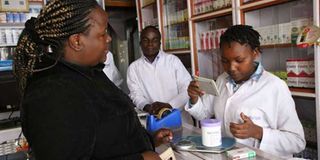Harmony in drugs regulation crucial

A woma buys medicine at a chemist. The regulation of medicines is crucial in the protection of the health and wellbeing of the people. FILE PHOTO | NATION MEDIA GROUP
What you need to know:
Stakeholders can streamline processes to reduce duplication and speed up the registration of medicines and medicinal products.
Several milestones have been established, such as the adoption of a standardised way of working.
The pharmaceutical industry wants the EAC to consider further engagements.
The regulation of medicines is crucial in the protection of the health and wellbeing of the people.
This is because it helps to ensure that patients have timely and regular access to safe, quality, and efficacious drugs.
This objective is met, thanks to the Harmonisation of Medicines Regulation programme that enables different countries or regions to make laws and guidelines that can be mutually adopted.
Through joint reviews of the information provided by manufacturers, stakeholders can streamline processes to reduce duplication and speed up the registration of medicines and medicinal products.
This concept was developed in the 1980s, with the formation of the ICH (International Conference on Harmonisation) comprising the United States, the European Union and Japan.
ADOPTED WORLDWIDE
It has since been adopted worldwide. In 2009, the African Union established the African Medicines Regulatory Harmonisation (AMRH) programme, which, according to the Nepad (New Partnership for Africa Development), seeks to establish standards and requirements on regulation and access to safe, quality medicines.
The agency oversees the registration of a selected list of medicines and coordinates regional harmonisation. In 2012, the East African version of the Medicines Regulatory Harmonisation (MRH) was launched to ensure access to safe, efficacious and quality medicines evaluated by regulatory experts from six countries (Burundi, Kenya, Rwanda, Tanzania, Uganda and Zanzibar-Tanzania).
The EAC would be the first regional bloc to adopt the framework for medicines harmonisation.
Several milestones have been established, such as the adoption of a standardised way of working.
This meant coming up with guidelines for registration and joint evaluation of medicines for treating priority diseases such as HIV, malaria, cancer, and tuberculosis and also antibiotics.
It was not designed to replace national regulatory bodies such as the Pharmacy and Poisons Board, but to be an institution of the EAC.
The Kenya Association of Pharmaceutical Industry (Kapi), which comprises more than 30 multinational and regional pharmaceutical firms, is a key stakeholder in the EAC-MRH programme.
Its core mandate is in line with Kapi’s vision of “Leading in the provision of innovative world class quality healthcare solutions, products and services”.
Kapi offered technical expert advice in the preparation of guidelines.
Since its inception, joint reviews of regulatory documents have been undertaken.
In 2014, the EAC partner states jointly inspected and registered two anti-malarial drugs and three generic ones in less than one year.
According to Nepad, the procedure was completed 30 to 40 per cent faster than usual, resulting in significant cost and time savings.
But as happens with any new process involving different countries with different laws and ways, it has been fraught with challenges.
MANUFACTURERS
One that needs looking into is mutual recognition so that medicines registered in Uganda, for example, do not undergo a full review in Kenya or Tanzania.
There is a need to harmonise the inspection of sites, and allow a review of documents from manufacturers based on the stringent regulatory authority regions such as the EU, US, Japan and Australia to speed up registration.
There should also be involvement of industry players during the development and formulation of guidelines, policy frameworks as well as regular review of progress during the implementation of the EAC-MRH goals.
The pharmaceutical industry wants the EAC to consider further engagements, including position papers on topics such as the formulation of a “one-stop shop”, where documents required for registration can be submitted.
Payments can be made and the revenue collected disbursed to each member state.
A central Internet portal is needed to help track, in real-time, the progress of all the applications and review the Key Performance Indicators.
If the legal and technical hurdles are sorted out, the process will be more applicable to the pharmaceutical industry in East Africa.
This model can then be replicated in other African regions.
Dr Karanja is executive secretary, Kenya Association of Pharmaceutical Industry (Kapi), and regulatory affairs head for East Africa of GlaxoSmithKline Pharmaceutical Kenya Ltd. [email protected]




